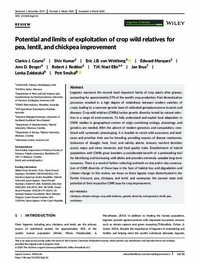Potential and limits of exploitation of crop wild relatives for pea, lentil, and chickpea improvement

Authors:
Legumes represent the second most important family of crop plants after grasses, accounting for approximately 27% of the world's crop production. Past domestication processes resulted in a high degree of relatedness between modern varieties of crops, leading to a narrower genetic base of cultivated germplasm prone to pests and diseases. Crop wild relatives (CWRs) harbor genetic diversity tested by natural selection in a range of environments. To fully understand and exploit local adaptation in CWR, studies in geographical centers of origin combining ecology, physiology, and genetics are needed. With the advent of modern genomics and computation, combined with systematic phenotyping, it is feasible to revisit wild accessions and landraces and prioritize their use for breeding, providing sources of disease resistances; tolerances of drought, heat, frost, and salinity abiotic stresses; nutrient densities across major and minor elements; and food quality traits. Establishment of hybrid populations with CWRs gives breeders a considerable benefit of a prebreeding tool for identifying and harnessing wild alleles and provides extremely valuable long-term resources. There is a need of further collecting and both ex situ and in situ conservation of CWR diversity of these taxa in the face of habitat loss and degradation and climate change. In this review, we focus on three legume crops domesticated in the Fertile Crescent, pea, chickpea, and lentil, and summarize the current state and potential of their respective CWR taxa for crop improvement
